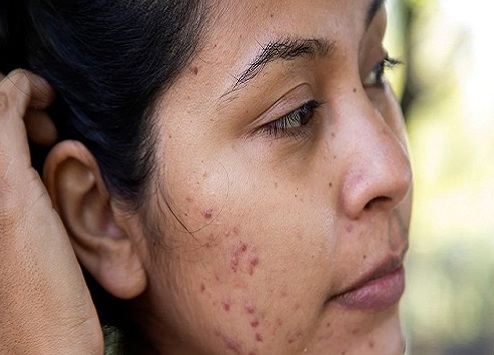
How Does Acne Cause Scars?
Inflammatory acne is formed by clogging the skin pores with excess sebum, dirt, dead skin cells, and acne-causing bacteria. This acne reaches deep into the skin and results in damage to the underlying skin tissues by swelling and breaking down the wall of the pores. Consequently, the body responds to the damage by boosting collagen fibres production. Unfortunately, the natural wound healing response does not go smoothly and results in flawless skin that appears the same as the normal, healthy skin, thereby causing acne scars.
Some acne scars are shallow and heal quickly because they are the result of inflammation of small acne blemishes. However, some acne scars are deeper, formed because of the spilling of the contents of acne blemished into the surrounding, healthy skin tissues.
Some people having acne breakouts are likely to develop scars when their acne clears. The risk is more in people who:
• Have inflammatory acne type- Often the cysts and nodules that tend to be deep-seated in the skin could cause greater skin damage and result in scarring.
• Delays or not properly treating inflammatory acne- the risk of scarring is greater in those who have got inflammatory acne for long periods.
• Squeezes, picks, or pops acne- These actions could increase swelling. The pus-filled acne may spill out its contents to the healthy surrounding skin and leave behind marks or scars.
• Have a genetic predisposition to acne scars- Heredity or family history of people developing acne scars could be a culprit.
Types of acne scars:
Mainly, acne scars are classified into three types:
1. Atrophic (depressed) scars: These look like small indentations or depressions in the skin. They are formed when the skin does not make sufficient fibroblasts (cells that are crucial in wound healing and the production of collagen and elastin fibers) in the natural healing process. Further, they are divided into three sub-types:
• Ice pick scars- These look like pitted or sunken indentations, like pinpricks. Their appearance is the same as that of an ice pick tool that has a wide shaft on its top which narrows down to the tip as it goes deep into the skin. They are common but very challenging scars to heal. Mostly, they are seen on the areas with thin skin like the upper cheeks and forehead.
• Boxcar scars- These are large, oval, or round-shaped skin indentations with clear, sharper edges that go deep into the skin. They commonly develop on the jaw and lower cheeks.
• Rolling scars- These are skin indentations with unclear edges that gives the skin an undulating, rolling appearance. They are mainly found in areas with thick skin like lower cheeks and jaw.
2. Hypertrophic (raised) scars: These skin lesions of scar tissues are formed when the skin starts producing abundant collagen fibers as the acne spot heals, causing them to rise off the skin. Usually, they are found on the back, chest, jawline, and shoulders.
3. Keloid scars: These are a kind of hypertrophic scar that tends to be thicker than the original acne spot and even darker (hyperpigmented) than the surrounding skin. They may appear brown or red and may be painful, tender, or itchy.
Treatment
Every type of acne scar cannot be removed with a particular acne treatment. This means every treatment option offers varying degrees of success depending upon the type and extent of acne scarring.
1. Subcision
Subcision, also referred to as subcutaneous incision - less surgery, is a minor surgical procedure to treat atrophic acne scars.The treatment involves the use of a tri - beveled hypodermic needle that is administered into the acne scar through a puncture in the surface of the skin, and its sharp edges to skilfully or carefully move under the defect to make subcuticular cuts. It is done to break apart the fibrotic strands that tether the acne scars to the underlying subcutaneous tissue. The depressed acne scars are lifted by this treatment and from the connective tissue that forms during the normal wound healing response.
2. Chemical peel
Chemical peeling involves the use of acids/special chemicals to exfoliate the skin- i.e. remove the top affected, old skin layer and allow the healthy, clear, smooth skin from underneath to present, that has fewer scars. There are three types of chemical peels: mild/superficial, medium, and deep peels which vary in the strength of the acid used and the degree of penetration. The most commonly used chemical peels to treat acne scars include glycolic acid, salicylic acid, resorcinol, Jessner’s solution, and trichloroacetic acid. Depending upon the type of chemical peel chosen, the treatment may be repeated several times for achieving and maintaining optimal results.
3. Dermal Fillers
Soft tissue fillers like hyaluronic acid, autologous fat, or other collagen - stimulating fillers like polymethylmethacrylate, poly - L - Lactic acid, silicon, and polyacrylamide can be administered into the skin to safely and effectively plump a few depressed / atrophic acne scars, but not ice pick scars. Most fillers provide us temporary results lasting for 6 to 18 months while some are semi - permanent and permanent too. Depending upon the type of filler used, the patient may need to repeat taking the treatment after some months.Silicon and polyacrylamide may never need replacement.
4. Laser skin resurfacing
In this treatment, ablative or non-ablative lasers are used to resurface the skin by delivering thermal energy to the scarred collagen underneath the skin with or without harming the superficial skin. The treatment relies on the body’s wound healing response to boost healthy collagen production and encourages the growth of new, healthy skin to replace acne scars.
It is preferred for reducing the appearance and texture of raised acne scars. Some common lasers that can be used to treat acne scars include carbon dioxide lasers, erbium YAG lasers, and pulsed - dye lasers.